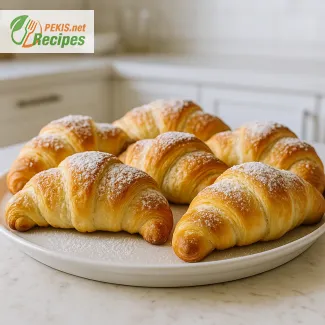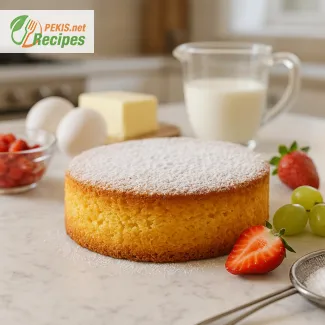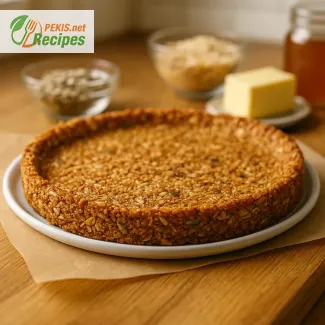
Crafting the Perfect Kataifi Dough from Scratch
Discover the delicate art behind traditional Kadaif noodles
Making kataifi dough at home is more than just preparing a pastry base—it's an invitation into the heart of Middle Eastern and Mediterranean desserts, where layers of fine, golden strands cradle luscious fillings like sweetened nuts, creamy cheeses, and aromatic spices. Known by various names such as kadaif, kataifi, or qadaif, this iconic ingredient forms the base of some of the region's most beloved pastries, including Kunafa, Ekmek Kadaifi, and Kataifi rolls.
Unlike phyllo dough or traditional pasta, kataifi noodles have a distinctive appearance and texture. They're spun into silky threads, resembling shredded wheat or angel hair, but they carry the tender crispness of baked phyllo when cooked. Despite their refined structure, these noodles are surprisingly easy to make at home with just a handful of ingredients. The challenge—and the beauty—lies in perfecting the pouring technique to create the iconic thin strands, which are then gently dried and stored for a variety of sweet or savory uses.
The appeal of homemade kataifi goes beyond taste. By crafting it yourself, you control the freshness, quality, and authenticity of your desserts. Commercially available kataifi can sometimes be too dry, stale, or overprocessed, which compromises both flavor and texture. Homemade kataifi, on the other hand, offers a buttery crispness and delicate chew that brings desserts to life. Imagine a warm plate of golden kataifi filled with pistachios and soaked in orange blossom syrup—each bite a balance of crunch and syrupy softness, elevated by your own handmade touch.
Kataifi dough also represents culinary storytelling. Across Turkey, Greece, the Levant, and even parts of North Africa, this dough has been passed down through generations, often reserved for festive occasions and celebratory feasts. Making it by hand ties you to centuries of bakers who’ve used this very technique to mark weddings, holidays, and family gatherings.
The process of making kataifi noodles requires patience and precision but also offers moments of joy and creativity. Watching the batter transform into delicate threads on a hot pan is a mesmerizing ritual. Whether you're making traditional desserts or experimenting with modern variations—like cheese-stuffed rolls, savory nests, or bite-sized party appetizers—kataifi is incredibly versatile.
One of the most compelling reasons to make kataifi dough from scratch is the accessibility of ingredients. A simple combination of all-purpose flour, cornstarch, salt, and water is all you need. There's no need for fancy equipment—just a squeeze bottle or piping bag and a good non-stick pan. This accessibility, combined with the sheer elegance of the final result, makes homemade kataifi a gratifying choice for both amateur bakers and experienced pastry chefs.
Moreover, kataifi is not just about tradition—it’s also about texture. In pastry making, texture is everything. While phyllo dough offers a flaky crunch, kataifi provides a multi-layered experience: crispy on the outside, chewy at the center, and perfectly absorbent for syrups and fillings. This makes it the perfect base for desserts that rely on contrast and depth, from Middle Eastern baklava-style treats to creative fusion tarts and mini nests filled with fresh fruit or chocolate ganache.
By learning how to make kataifi noodles at home, you’re expanding your baking repertoire with a skill that’s both impressive and surprisingly simple once mastered. The result is a pastry element that elevates any dish it touches—transforming your kitchen into a place of sensory magic. The subtle sizzle of batter hitting a hot pan, the golden strands curling and drying, and the rich scent of butter and nuts all come together to create a truly immersive experience.
Stay tuned for the full recipe, where we’ll guide you step-by-step through the process of making authentic kataifi dough, from mixing the batter to spinning the perfect strands. With this skill in hand, your desserts will never be the same.
- Prepare the batter: In a mixing bowl, combine water (250 ml / 1 cup), all-purpose flour (100 g / ¾ cup), cornstarch (30 g / ¼ cup), and fine salt (1 g / ¼ tsp). Whisk thoroughly until the mixture becomes smooth and lump-free. The batter should be slightly thinner than pancake batter.
- Rest the batter: Cover the bowl and let it rest at room temperature for 15–20 minutes to allow any bubbles to settle and to hydrate the flour properly.
- Prepare the pan: Heat a non-stick skillet or flat griddle over medium-low heat. Lightly grease the surface with neutral oil using a brush or paper towel.
- Transfer batter to a squeeze bottle or piping bag: Use a plastic squeeze bottle or a piping bag fitted with a very small round tip to get thin strands. Test the flow to ensure the batter can be poured in threads.
- Create the noodles: Hold the bottle or bag a few centimeters above the pan and quickly move your hand in back-and-forth motions to form thin, noodle-like strands. Each kataifi noodle batch should cook for about 1 minute or until it is dry to the touch and easy to peel off the surface (do not brown it).
- Cool and store: Carefully lift the kataifi noodles off the pan and place them on a clean kitchen towel to cool. Repeat with remaining batter. Once cooled, the noodles can be used immediately or stored in an airtight container for up to 3 days.
Enhancing the Art of Kataifi Dough at Home
Secrets to elevating the flavor, texture, and quality of homemade kadaif noodles
Mastering kataifi dough is a rewarding achievement for any passionate cook, but what truly sets a homemade version apart is the ability to fine-tune it to your own taste, texture preferences, and dietary needs. While the traditional recipe provides an excellent base, there are several ways to improve the overall outcome, whether by tweaking the ingredients, adjusting cooking techniques, or simply avoiding common pitfalls. Let’s explore how to take your kataifi dough to the next level with a few expert tips and creative touches.
Small changes, big flavor: ingredient upgrades
Though kataifi dough is naturally neutral in flavor—designed to complement sweet syrups or savory fillings—minor ingredient substitutions or additions can dramatically improve the final dish:
- Switch water for milk (250 ml / 1 cup): Using whole milk instead of water will add richness and a slightly creamier mouthfeel to the strands. This works particularly well for sweet recipes where buttery textures are desired.
- Add a touch of melted butter (1 tbsp / 15 g): Adding just a small amount of melted unsalted butter to the batter improves the dough’s flexibility and browning quality without compromising its structure.
- Include egg white (1 large egg white): For added structure and a delicate crisp, especially for savory dishes, egg whites help reinforce the texture of the noodles. However, this addition reduces shelf life and may not be suitable for vegans.
- Use a blend of flour types: Combining all-purpose flour with fine semolina (in a ratio of 3:1) creates a slightly grittier bite and enhances moisture absorption—perfect for syrup-based desserts like kunafa.
- Flavor infusion: A few drops of orange blossom water, rose water, or even vanilla extract can gently infuse the batter with a floral or aromatic note, making the final dish feel more luxurious and festive.
The undeniable value of homemade kataifi
One of the greatest strengths of making kataifi dough yourself is the freshness. Commercially available kadaif often lacks the tender texture and clean taste of a homemade version. Store-bought strands may be overly dry, too dense, or even contain preservatives, which can subtly affect the flavor and performance in baking.
Homemade kataifi has:
- Superior moisture control – it absorbs syrup better without becoming soggy.
- Better separation – strands are less likely to clump and are easier to shape.
- Cleaner, neutral taste – which allows the fillings or toppings to shine.
In addition, freshly made dough is easier to shape into nests, rolls, or layered cakes, giving you full control over the final presentation of your dish.
Avoiding common mistakes
Even though kataifi dough uses only a few ingredients, precision is key. Here are some frequent mistakes and how to avoid them:
- Too thick batter: If your batter resembles pancake mix, the strands will be uneven and heavy. Add water gradually to ensure a smooth, fluid consistency.
- Overheating the pan: If the pan is too hot, the batter cooks too fast and browns before it forms even strands. Always keep heat medium-low for best results.
- Clogged nozzle or piping tip: A narrow tip is essential, but it should still allow for smooth flow. Test before pouring onto the pan.
- No resting time: Allowing the batter to rest ensures better hydration of the flour and fewer bubbles, resulting in smoother pouring and consistent texture.
- Improper storage: Once cooked and cooled, the noodles should be stored in an airtight container to prevent drying out and to preserve their crispness.
Healthier alternatives for a modern twist
While kataifi is not inherently unhealthy, there are ways to make it lighter or more suitable for specific dietary needs:
- Use whole wheat flour: Substituting part of the all-purpose flour with whole wheat flour adds fiber and nutrients without dramatically affecting the texture.
- Go gluten-free: A mix of rice flour, tapioca starch, and xanthan gum can mimic the elasticity of wheat-based batter. Results may vary, so experimentation is encouraged.
- Bake instead of fry: If you're using kataifi for savory recipes, consider baking the formed pastries with a light brush of olive oil instead of frying for a healthier, lower-fat result.
- Vegan version: The basic recipe is naturally vegan. Just ensure any added ingredients (like milk or egg white) are substituted with plant-based alternatives, such as oat milk or aquafaba.
Textural innovation and creative shaping
Beyond ingredients, one way to elevate your kataifi dough is to experiment with shapes and sizes. Traditional kataifi is shredded into fine, long strands, but you can shape them into:
- Mini nests for appetizers or tart bases
- Tightly rolled cigars filled with nuts or cheese
- Layered sheets in a springform pan for modern kataifi cakes
- Wrapped vegetables or seafood for gourmet-style savory dishes
These modern applications make kataifi more than a traditional dessert element—it becomes a versatile foundation for innovation.
In its purest form, kataifi dough is simple, but its potential is vast. By adjusting a few elements, focusing on ingredient quality, and staying mindful of technique, you can elevate a basic recipe into a refined, flavorful canvas. Whether you're preparing it for festive desserts or stylish savory starters, homemade kataifi offers not only better results, but also a richer, more rewarding cooking experience.
Allergens and gluten:
- Contains gluten (wheat flour)
- May contain traces of corn allergens due to cornstarch
Substitution tips:
- For gluten-free version, use gluten-free all-purpose flour and ensure the cornstarch is certified gluten-free.
- For corn allergy, substitute cornstarch with potato starch or rice starch in equal measure.
- Vitamin B1 (Thiamine): 0.12 mg – supports energy metabolism and nerve function
- Vitamin B3 (Niacin): 1.5 mg – aids digestion and skin health
- Iron: 1.2 mg – contributes to oxygen transport and immunity
- Magnesium: 10 mg – important for muscle and nerve function
- Phosphorus: 50 mg – supports bones and energy production
- Zinc: 0.3 mg – aids immune system and wound healing
- Lutein + Zeaxanthin: 40 mcg – promotes eye health and protects against oxidative stress
- Selenium: 1.1 mcg – supports thyroid function and reduces inflammation





